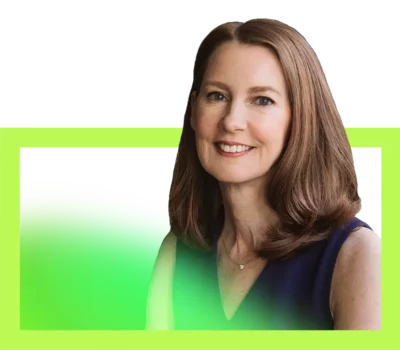It’s ok to be wrong
Gretchen Rubin is an expert on happiness, and she’s spent her career helping people build the habits to achieve it. But she assumed that if something works for her, it should work for just about anyone. A series of chance encounters, and a healthy helping of curiosity, makes Gretchen realize that maybe there isn’t one path to happiness after all. That there’s no right or wrong way to build a meaningful life, just the way that works for you.


Table of Contents:
Transcript:
It’s ok to be wrong
GRETCHEN RUBIN: Often, when I ask about habits, people tell me things like, “I make so many promises to myself that I never keep” or “I keep telling myself I’m going to get back into meditation and then I just never do.” Weary resignation, disappointed aspirations. But her reaction is completely different. It’s not that she wants habits and can’t maintain them. She rejects the entire aim of having habits in the first place.
That someone might feel this way has simply never occurred to me.
She looks at me as if she wishes she could pull out a string of garlic to ward me off. So of course I want to push her, to see how far this idea goes for her.
ROHAN GUNATILLAKE: In a string of New York Times best sellers, Gretchen Rubin writes about happiness, habits, and human nature. She also hosts the “Happier” podcast which you might want to add to your list if you’re not already a listener. Her most recent book, Outer Order: Inner Calm, traces the connections between happiness and personal habits, and is the inspiration for the Meditative Story she’s about to share with you. It’s a lighter story, one that will make you smile, and bring out feelings I bet you can relate to but may not have summed up in quite the way Gretchen does here.
In this series, we combine immersive first-person stories, breathtaking music, and mindfulness prompts so that we may see our lives reflected back to us in other people’s stories. And that can lead to improvements in our own inner lives.
From WaitWhat, this is Meditative Story. I’m Rohan, and I’ll be your guide.
The body relaxed. The body breathing. Your senses open. Your mind open. Meeting the world.
RUBIN: It’s a lovely summer night in New York City. I stand with a bunch of people on the terrace of a sprawling apartment in midtown Manhattan. I notice the hot gritty breeze, the sight of the rooftops around us, and the sounds of cars honking far below. The terrace has an urban, minimalist look: wood and concrete and lots of spiky plants that I can’t name. The women wear sundresses and sandals, the men are dressed in business casual. As dusk falls, we stand beneath the glowing string lights laced across the rooftop.
We’re here to celebrate the publication of my new book, on happiness at home. But I’m already thinking about my next project, on a topic I’m obsessed with: habits, how we can master our habits. I loved working on the book we’re all here for, but now this new idea is on my mind, and I can’t let it go. I can’t help it. It’s just such a juicy, delicious topic for me – I love thinking about habits.
As I make casual conversation with one group after another, I keep fishing for fresh habit-related insights. I ask questions like: “How do you feel about New Year’s resolutions?” or “Do you ever find it hard to keep your promises to yourself?”
At some point, I strike up a conversation with a woman I know slightly. She’s striking. Her style is pin-up tattoo. She has bright red lipstick, elaborate hair, is slightly retro, and with several tattoos. Her whole look is deliberately, unironically ironic. Very Brooklyn. I remember thinking, “She’s much hipper than you, Gretchen.”
“What are you working on now?” she asks me. I answer, “Habits. How we can make or break habits.” She has such a visceral reaction that she literally takes a step back as the word leaves my mouth. With surprise — and something bordering on disgust — she asks, with such sincere astonishment that it makes me laugh, “Why would you ever want to study such an awful subject?”
Now, this is interesting. My feelings aren’t hurt. I’m just so curious. She’s clearly repulsed by the idea. And yet to me, there’s nothing more compelling than a life full of habits. There can never be enough!
I tell her how I feel; she shakes her head. “Habits are chains,” she says. “Who wants to live like that? I don’t want to do anything that someone else tells me to do. I don’t even like to tell myself what to do!”
Often, when I ask about habits, people tell me things like, “I make so many promises to myself that I never keep” or “I keep telling myself I’m going to get back into meditation and then I just never do.” Weary resignation, disappointed aspirations. But her reaction is completely different. It’s not that she wants habits and can’t maintain them. She rejects the entire aim of having habits in the first place.
That someone might feel this way has simply never occurred to me.
She looks at me as if she wishes she could pull out a string of garlic to ward me off. So of course I want to push her, to see how far this idea goes for her. “So… how do you feel about something like marriage?” I ask her.
“Well, I’ll tell you,” she responds, “I love my husband very much, but I have a lot of problems with monogamy. I don’t like anybody telling me what I can or can’t do.”
I think, “Oh, okay.” I accepted the whole concept of monogamy pretty quickly. I never really paused to question it.
I realize that she sees the world in a profoundly different way from me.
My mind is blown. I always assumed that everybody feels about habits the way I do — that they want habits the way that I do. They just haven’t figured out how to get there. Not her. If we had more time, I’d ask her more questions so I could study her like a specimen beneath a microscope. But we’re holding our cocktails, the ice long since melted, and now other people join the conversation; it’s time to talk about other things.
I think about this woman, and what she says to me on that rooftop, for years to come. She gives me a profound insight into human nature. She hasn’t changed my mind – she wasn’t trying to — but she opens a window for me, and illuminates something which sounds so obvious, but I’d never really quite grasped: my way of doing things is not the only way.
GUNATILLAKE: Notice how when Gretchen encounters this person with a radically different position from hers, her first move is one of curiosity, not of rejection. Can you embody that spirit of curiosity in this moment? Alert, open, interested.
RUBIN: I’d always assumed that if something works for me, it would work for just about anyone. But she makes me realize that there’s no one right way to become happier, healthier, more productive, or more creative. We each have to know ourselves.
My sister Elizabeth teaches me the same lesson. Elizabeth is clutter blind.
She’s very messy, my sister. Now, she isn’t dirty. There aren’t sandwich crusts or apple cores strewn around, no greasy napkins or used Kleenex. It’s just… well… cluttered. She doesn’t put things away; she just puts things down and leaves them there, sometimes for months, sometimes for years. My sister is the kind of person who sees no reason to make her bed in the morning. It just doesn’t make a difference to her, one way or the other.
When we were growing up, I kept neat piles of books and class notes organized on my desk, and she kept her textbooks strewn across the floor. She had a pile of almost-empty notebooks lying around, each with just one page of notes that she made two years ago.
I love clearing clutter, and nothing’s more fun for me than going to her house to clear her clutter — it’s one of my favorite things to do. One visit I stay with her, in her house in Los Angeles, and we embark on one of our epic declutters, of the home office she shares with her husband. His stuff, I’m not allowed to touch.
We dive in.
It’s March, but there are still Christmas wrapping paper rolls left out. There’s a big box of decorations from New Year’s Eve, a hat and bedazzled glasses in the shape of “2019” sit on top. There are empty shopping bags and cardboard boxes all around the room.
Elizabeth has a fabulous Hollywood career, so there’s also a lot of random TV and movie swag sitting around the office. We decide what stays and what goes.
“Wouldn’t you like to give away this branded martini shaker?” I ask, with an obviously leading question. “Especially given that you never make martinis? Isn’t there someone else who might enjoy this?”
She sits on her sofa, sips a Diet Coke, and tells me what I can and can’t get rid of. We create a recycling pile and a pile for donations.
I’ve decluttered with her before — many times, in fact. During previous visits, I encouraged her to deal with: nine bridesmaids dresses; two fondue sets, never used; dozens of dried-up pens and whiteboard markers; bright red glitter shoes like the ones Dorothy wore in Oz. Once, we found a bag of unopened mail that she brought with her when she moved from New York City to Los Angeles, all still unopened.
In this clutter-clearing, I spot the old neglected fax machine that’s occupying a lot of space in the cabinet. The last time I’d visited, I’d urged her to get rid of it.
“Do you think we could finally get rid of the fax machine?” I ask. “Because you’re not going to get a fax. Because A, no one’s sending you a fax. And B, you don’t even have it plugged in.”
After I stubbornly stand there for five minutes, she relents.
Here’s what I realize. Elizabeth allows me the pleasure of clearing her clutter, because she knows how much I enjoy the process. And it’s true, once the clutter is gone, she enjoys having the extra space and having things put away. But really, outer order just doesn’t matter very much to her; she doesn’t see the mess, it doesn’t weigh her down. Even though she has always told me, “I don’t care,” it’s hard for me to accept. How can she not care? But she really doesn’t, not the way I care.
Our difference doesn’t annoy her, it amuses her. She even finds it endearing. For me, outer order contributes to inner calm, and out of love, I want to help her create outer order. And out of love, she lets me do it.
GUNATILLAKE: Clutter isn’t only something on the outside. There’s also inner clutter: scattered thoughts, judgements, the wanderings of the mind. Breathing in, letting in the new. Breathing out, letting the clutter make its way out.
RUBIN: Months later, I’m in a chilly green room, waiting for my turn to speak at a big conference in Texas. I’m giving a talk that I haven’t given before, so I spend some time reviewing my notes to make sure I know exactly what I’m going to say.
After I’m confident that my talk is safely in my head, I stuff the typed pages into my backpack and start a conversation with the speaker who will follow me. He sits on the other end of the overstuffed faux leather couch.
“You use notes,” he observes.
I nod. “I always write out what I’m going to say.”
“My staff wishes I’d do that,” he says as he gulps coffee from a styrofoam cup. “I drive them crazy. I don’t decide exactly what I’m going to say until I’m getting mic’d up backstage. I always get my best ideas at the last minute.”
He says this casually, but I’m stunned. I can’t imagine preparing to speak to a crowded room with nothing figured out except the title and a one-sentence description.
But his comment snaps something into focus for me, something I’d half-noticed but never acknowledged: some people are marathoners, some people are sprinters when it comes to their work pace. Marathoners like me like to start work early and proceed steadily, with plenty of time. Sprinters, like my fellow speaker, need the pressure of a deadline to spark their creativity and clarify their thinking. They do their best work at the last minute.
I need to start preparation early; he does better when he waits. What works for me doesn’t work for him, and vice versa. Which brings me back to the terrace on that summer evening in Manhattan. Just like the woman with the red lipstick, other people see the world in a profoundly different way from the way I see it.
It feels obvious to me that “habits help make life happier” and “outer order contributes to inner calm” and “slow and steady wins the race,” but I realize: that’s true for me. But not for everyone.
And of course, sometimes I’m the one on the other side of people’s confident, well-meaning, and misguided advice.
People often urge me, “Oh sure, you have a sweet tooth. But it’s not healthy to be too rigid with yourself. Have just one or two Thin Mint cookies. Have half a dish of ice cream. Follow the 80/20 rule.” But I can’t. I can have no cookies, or I can have lots of cookies. I can’t have just one cookie.
I used to think, “What’s wrong with me? I have no willpower, I have no self-control. Other people can keep a bar of fine chocolate in their desk drawer, and every day or two, eat just one square. Why can’t I do that?” But I finally realized that it’s easier for me to abstain totally than to indulge in moderation. That’s not true for everyone, but it’s true for me.
The larger question is: Given my nature and my circumstances, can I do better? Of course. Better is my whole deal.
I used to feel smug, secure in my conviction that what worked for me would work for everyone. I would try to bring everybody into my way of sticking to a schedule, making my bed, not procrastinating, and quitting sugar.
It’s taken me a long time to understand how different we all are. There’s no right way, no wrong way, just the way that works for us; we all need to set up our lives in a way that’s right for us. There is no magical one-size-fits-all solution.
Now, I have a forceful personality. My sister refers to me as a “happiness bully” because if I think there’s a way for a person to become happier, I can become quite insistent.
If I see that there’s something for people to do that I believe will make them happier, I’m not shy about sharing it. I don’t try to influence career-altering decisions like, “You should go to law school.” More like, “If you want to exercise regularly, here’s how I think you could set yourself up for success.”
I can come on pretty strong. And by now I really do have a strategy for just about everything, and I will try very hard to convince you to give it a shot. I try to be aware of this tendency, and I make fun of myself for it. I just can’t help myself. If I think there’s a way for you to be happier, I really want to talk about it. Even if you don’t want to talk about it!
But at least now I appreciate that people see the world in a way that’s different from the way I see it. I understand better why some aspects of my nature might annoy other people, or frustrate them, even though what I’m doing seems perfectly appropriate and right to me.
Now when I hear people say, “You’ve got to do it this way. This is the best way, the most efficient way,” I think, “No, no, no, no, no.” For some people, that’s almost certainly going to be bad advice. Some people should get up early, and some people should stay up late. Some people should make to-do lists and schedules, and some people should do what they feel like doing, whenever they feel like doing it. There’s no one way to be happier, healthier, more productive, or more creative.
A central tension in a happy life is that we want both to accept ourselves, and expect more from ourselves. And what I’ve come to believe is that only you can decide what you’re going to accept about yourself, and what you’re going to expect from yourself, and what that means. No one can decide that for you.
Because I thrive with structure, routine, and habit, it’s tempting for me to try to order my family to go to bed by a certain time, wake up at a certain time, and maintain a long to-do list. I want to start every day with a conversation. “What are you planning to get done today?”
One way we express love is through involvement and support. And one way we try to control people is through involvement and support. We constantly have to figure out how to walk that tightrope.
Now, unless someone invites me in to help solve a problem, I try to put down the figurative clipboard and remind myself: I’m not the boss of the world. I can laugh at myself. I can accept that we all see and do things differently. You are the best judge of what’s right for you.
Yes, Gretchen, just put down the clipboard.
Rohan’s closing meditation
GUNATILLAKE: Thank you, Gretchen. When Gretchen talks about putting down the clipboard, what comes to mind for me is the idea of accepting. Accepting doesn’t mean running away, or dismissing what is happening. Instead, it is about being free. So accepting and freedom is what this meditation we’ll explore together is about.
Let’s go.
However your body is, inviting it to relax. Inviting the mind to relax. And in this meditation, we’re going to just let the mind be free. Letting our attention roam free. And while it roams, our job will be to watch it. Just watching where the mind goes. That is all. Letting the mind go. Letting it do what it wants. And all we do is watch it, observe it. With interest. And without judgment.
Ok. Inviting the body to relax. Inviting the mind to relax. Inviting the body/mind to relax. Inviting the heart to relax. And again. Letting the mind be free. Not asking it to do anything in particular. And all we do is watch.
Ok. We’ve let the mind roam free. We’ve watched it, with interest and without judgment. And now we’re going to see what more we can learn. When the mind is free to go where it wants, where does it go? When the mind is free to do what it wants, what does it do? What patterns can we learn? What habits? Where does our mind go? What sensations does it go out to look at?
Letting go sounds like an easy thing to do. But the reality is that our minds are so used to getting caught up. Through meditation though, we start to see where the mind gets caught. And when we see those patterns, they start to lose their power. So let’s look. Let the mind be free and notice how and why it is not free.
Watch.
Learn.
Watch.
Learn.
Seeing over and over again what gets in the way of our letting go. This is how we get better at letting go.
Ok. We’re coming to the end of this meditation now. We let the mind be free and without agenda, without clipboard. And then started to notice what happens when we left it to its own devices. Because the more we see the habits, the less power they have. If there is a golden rule of mindfulness, that’s basically it.
Thank you and take care.





